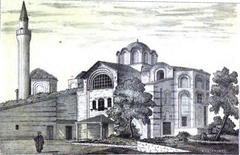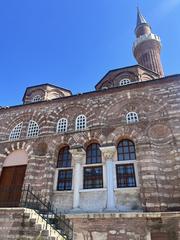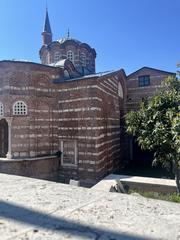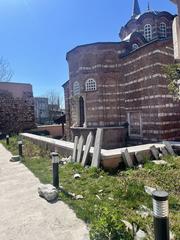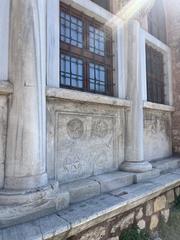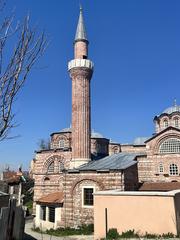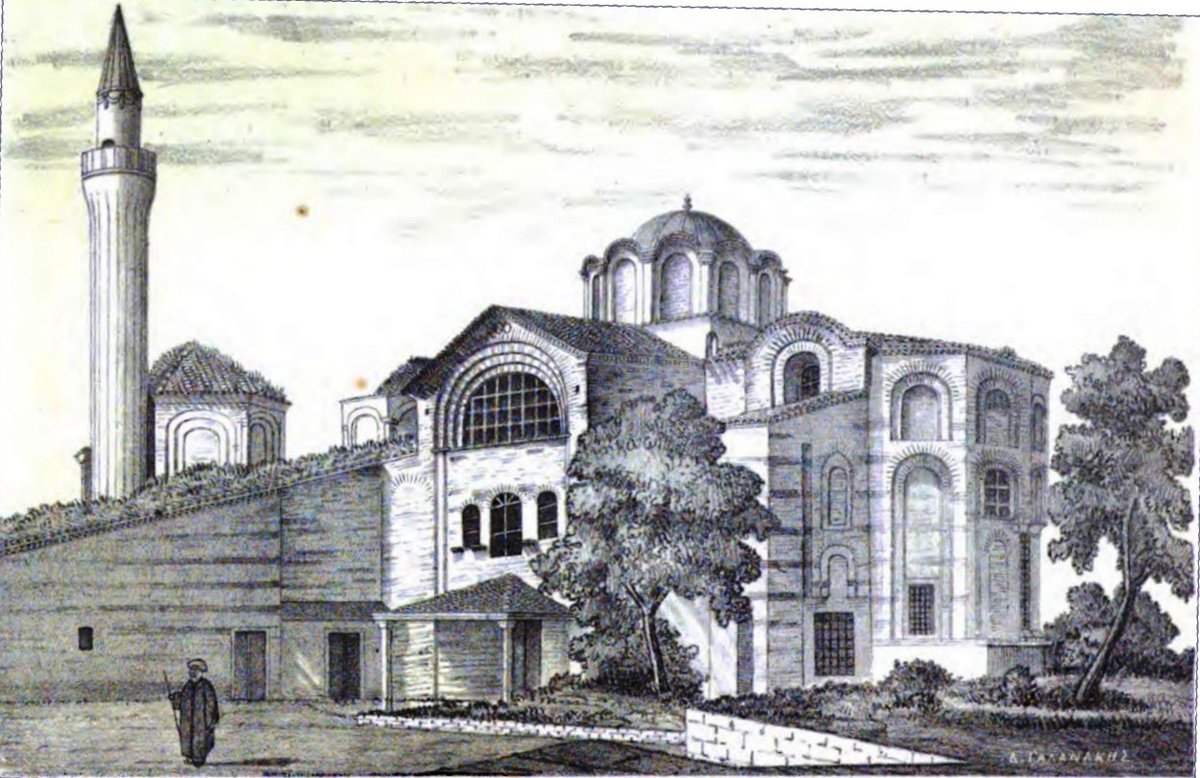
Molla Gürani Mosque: Visiting Hours, Tickets, and Historical Significance in Istanbul
Date: 14/06/2025
Introduction
Nestled in Istanbul’s historic Vefa district, the Molla Gürani Mosque—also known as Vefa Kilise Camii—offers a captivating window into the city’s rich Byzantine and Ottoman heritage. Originally constructed as a Byzantine church dedicated to St. Theodoros, this monument has witnessed centuries of transformation, from its 6th-century origins and Middle Byzantine renovations to its conversion into a mosque following the Ottoman conquest in 1453. Today, it stands as a testament to Istanbul’s complex religious and architectural history, inviting visitors to explore a unique synthesis of Christian and Islamic elements. This comprehensive guide details the mosque’s historical evolution, architectural highlights, visitor information, travel tips, and nearby attractions, ensuring an enriching experience for anyone exploring Istanbul’s lesser-known treasures (Kultur Envanteri; Istanbul Tips; Nomadic Niko).
Table of Contents
- Historical Background
- Architectural Highlights
- Visiting the Molla Gürani Mosque: Hours, Tickets, and Guidelines
- Enhancing Your Visit: Travel Tips and Nearby Attractions
- Frequently Asked Questions
- Summary Table: Key Architectural Features
- Conclusion and Call to Action
- References and Further Reading
Historical Background
The Molla Gürani Mosque, originally the Church of St. Theodoros, was constructed during the Early Byzantine period. Its earliest elements, such as columns and balustrades, date back to the 6th century CE, marking Constantinople’s stature as the heart of the Byzantine Empire (Kultur Envanteri). The church was later expanded and transformed in the Middle Byzantine era (9th–12th centuries), adopting the classic cross-in-square plan and incorporating spolia from earlier structures.
Following the Ottoman conquest in 1453, the building was converted into a mosque under the guidance of Molla Gürani, Istanbul’s first mufti and a prominent Islamic scholar (Nomadic Niko). The conversion included Islamic architectural features such as a mihrab and minbar, while much of the Byzantine structure was preserved. Over the centuries, the mosque has sustained damages—including a significant fire in 1833—followed by restorative efforts in 1848 and a comprehensive renovation between 2017 and 2021, revealing new discoveries and ensuring its preservation (Academia.edu).
The mosque continues to serve as an active place of worship and a living monument to Istanbul’s multicultural and religiously layered past.
Architectural Highlights
Byzantine Foundations
- Plan: The mosque retains the cross-in-square (quincunx) plan, typical of Middle Byzantine churches from the 10th–12th centuries (The Byzantine Legacy).
- Dome: A central dome, supported by four pillars, dominates the interior, with pendentives providing the transition from square base to circular dome (The Byzantine Legacy).
- Masonry: The distinctive recessed brick technique, with bricks set back in thick mortar, gives the exterior walls a textured appearance (Wikipedia).
- Decorative Elements: Blind arcades and Byzantine motifs—such as snake patterns—adorn the exterior, while 6th-century columns and balustrades reflect the use of spolia (Wikipedia).
Palaiologan and Ottoman Additions
- Outer Narthex: A five-bay outer narthex, added after the Latin occupation (1204–1261), exemplifies late Byzantine architecture (Kültür Envanteri).
- Islamic Elements: After its conversion, the building gained a mihrab (prayer niche) and minbar (pulpit). The orientation of the mihrab toward Mecca contrasts with the church’s original east-facing apse, symbolizing its religious transformation (Archiqoo).
- Restoration: Major repairs in 1848 replaced original columns and removed many mosaics. Restoration from 2017 to 2021 focused on structural stability and the conservation of decorative elements (Wikipedia; Academia.edu).
Artistic Heritage
- Interior: Remnants of mosaics, though mostly whitewashed, have been partially uncovered during recent restoration.
- Exterior: The interplay of brick and marble, along with triple lancet windows in the apse, creates a visually striking façade.
Visiting the Molla Gürani Mosque: Hours, Tickets, and Guidelines
Location and Access
The mosque is centrally located in the Vefa district, within walking distance of major landmarks such as the Süleymaniye Mosque and the Valens Aqueduct. Public transportation options include the Vezneciler tram stop and several bus lines.
Visiting Hours
- Open: Daily from 9:00 AM to 6:00 PM (may vary seasonally).
- Closed: During the five daily prayers—Sabah (dawn), Öğle (midday), İkindi (afternoon), Akşam (sunset), and Yatsı (night)—and especially during the Friday Jumu’ah prayer (The Istanbul Insider).
- Tip: Always check local notice boards or official websites for changes in opening times or special events.
Tickets and Entry
- Admission: Free; donations are appreciated for upkeep and community support.
- Guided Tours: Available via local tour operators; inquire in advance for historical and architectural insights (Istanbul Tour Studio).
Dress Code and Visitor Etiquette
- Dress Modestly: Women should cover hair, shoulders, and knees; men should wear long trousers.
- Shoes: Remove before entering; bring a plastic bag to carry them if not provided.
- Photography: Permitted, but avoid flash and respect worshippers by not photographing during prayers (The Istanbul Insider).
- Behavior: Speak quietly and avoid loud noises; silence your phone; maintain cleanliness (Turkey Travel Planner).
Facilities and Accessibility
- Restrooms: Available and typically clean (Lets Venture Out).
- Accessibility: The historic structure and steep surrounding streets may present challenges for visitors with mobility issues.
Enhancing Your Visit: Travel Tips and Nearby Attractions
Nearby Attractions
- Süleymaniye Mosque: A short walk away, this Ottoman masterpiece is a must-see.
- Valens Aqueduct: A striking Roman-era monument nearby.
- Vefa Bozacısı: The city’s oldest boza shop, renowned for its traditional fermented wheat drink (Nomadic Niko).
- Other Religious Sites: Sheikh Ebül Vefa’s tomb and the Molla Hüsrev Mosque are also in the vicinity.
Best Times to Visit
- Early mornings or late afternoons on weekdays are ideal for a quieter and more reflective experience.
- Avoid Fridays at noon due to the special congregational prayer.
Additional Tips
- Language: Some staff or volunteers may speak English, but learning basic Turkish greetings enhances your visit.
- Safety: The Vefa district is generally safe; exercise normal caution with valuables.
Interactive Map
Explore the Molla Gürani Mosque and Vefa district on Google Maps.
Frequently Asked Questions
Q: What are the visiting hours of Molla Gürani Mosque?
A: Open daily from 9:00 AM to 6:00 PM, except during prayer times. Verify locally for seasonal variations.
Q: Is there an entry fee?
A: No; entrance is free, but donations are appreciated.
Q: Can non-Muslims visit?
A: Yes, outside of prayer times. All visitors must respect mosque etiquette.
Q: Is photography allowed inside?
A: Yes, but avoid flash and photographing worshippers.
Q: Is the mosque accessible for those with mobility issues?
A: Accessibility is limited due to the historic structure and hilly terrain.
Q: Are guided tours available?
A: Some local operators offer guided tours; check availability in advance.
Summary Table: Key Architectural Features
| Feature | Description | Period/Origin |
|---|---|---|
| Plan | Cross-in-square (quincunx), nine-bay naos, tripartite bema | Middle Byzantine (11th–12th c.) |
| Dome | Central, supported by four pillars | Byzantine |
| Masonry | Recessed brick technique, thick mortar beds | Byzantine |
| Decorative Motifs | Blind arcades, snake patterns, triple lancet window in apse | Byzantine |
| Outer Narthex | Five-bay, added after 1261 (Palaiologan period) | Late Byzantine |
| Islamic Additions | Mihrab, minbar, adaptation for Muslim prayer | Ottoman (post-1453) |
| Surviving Elements | 6th-century columns and window balustrades | Early Byzantine (spolia) |
| Restoration | Major campaigns in 1848, 1937, 2017–2021 | Modern |
Conclusion and Call to Action
The Molla Gürani Mosque stands as a living testament to Istanbul’s vibrant history and religious coexistence. Its unique blend of Byzantine and Ottoman features, combined with its ongoing role as a place of worship and community, make it a compelling destination for any visitor interested in the city’s cultural legacy. Plan your visit to experience this hidden gem, and enrich your exploration with resources like the Audiala app, which offers updated visitor information, guided audio tours, and interactive maps. For more travel tips and inspiration, follow us on social media and explore our related articles.
Experience the harmony of Istanbul’s past and present at the Molla Gürani Mosque—a must-see for every traveler with an eye for history and architecture.
References and Further Reading
- Kultur Envanteri
- Istanbul Tips
- The Byzantine Legacy
- Nomadic Niko
- Academia.edu
- Istanbul Tour Studio
- The Istanbul Insider
- Turkey Travel Planner
- Archiqoo
- Lets Venture Out
